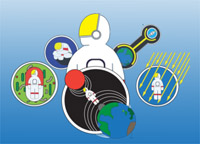Medical Effects of Spaceflight
 Certain negative effects appear with every space flight on almost all crew members, such as a headward fluid shift and muscle deconditioning. Other effects, however, are not very consistent and do not always occur. A few of these include nausea, headache, backache, congestion and insomnia.
Certain negative effects appear with every space flight on almost all crew members, such as a headward fluid shift and muscle deconditioning. Other effects, however, are not very consistent and do not always occur. A few of these include nausea, headache, backache, congestion and insomnia.
Astronauts take medicine to alleviate the pain or discomfort caused by the body's adaption to space. Medications carried on Space Shuttle missions have varied somewhat from flight to flight, depending on the individual needs of crewmembers.
Before determining what measures are to be taken in space, it is first essential to define how exactly space effects the physiology of the systems of human beings. A fluid shift results as blood and other fluids move from the feet, legs, and lower trunk to the upper body, the upper trunk, and the head.
This fluid shift causes at first the heart to enlarge in order to handle the increased blood flow. This "flooding" in the upper part of the body causing the body, through negative feedback, to correct this situation by getting rid of some of the "excess" fluid.
The astronauts become much less thirsty than normal, and the kidneys increase the output of urine. Both these actions decrease the overall quantity of fluids and electrolytes. Once the fluid level decreases, the heart shrinks back to its normal shape and size.
Adaptation of the heart and the cardiovascular system to microgravity is rapid and effective. The adaptation is primarily a general response to a headward shift of body fluids. The concentration of red blood cells (or RBCs) stays about the same, surprisingly, even though plasma volume decreases in space.
As humans are exposed to the microgravity of space, there is a loss of fluid. This suggests that the concentration of RBCs should increase. However, this does not happen. Thus, the concentration of RBCs must be somehow decreasing.
This reduction of RBCs is known as "space anemia". This happens through negative feedback. As the concentration of fluid decreases, the kidney reduces the production of erythroprotein which in turn surpresses RBC formation. Thus the concentration of RBCs is maintained in the blood preventing any extremities.
Human muscles adapt to new situations. When we need our muscles, we can activate them almost immediately. When a person does not use his muscles for a period of time, the muscles begin to waste away or "atrophy". Astronauts, while in space do not require the use of their "anti-gravity" muscles and thus experience this natural atrophy.
When astronauts return to earth, these muscles can still cause problems. Thus, in microgravity, tension is reduced on muscles that support the body against gravity, resulting in a loss of muscle mass and an accompanying loss of muscle strength.
The main problem to be faced is that exposure to microgravity causes a reduction in the endurance capacity of skeletal muscle. A reduction in bone marrow also results due to the absence of gravitational force. In certain parts of the body (like the legs) this loss can amount to 1.5% per month, thus resulting in an unacceptable loss for a mission that takes approximately 2.5 years.
The awareness and perception of our body's orientation on Earth is attributed, in part, to the detection of gravity by the otolith organs, or the utricle and the saccule, and to the detection of the rotational movements by the semicircular canals, both of which are in the inner ear.
Gravity sensors in the joints and the touch sensors in the skin are also involved, and the eyes contribute by sensing the body's relationship to other objects. However, the otolith organs are stimulated differently in the weightless environment of space where the resulting signals no longer correspond with the visual and other sensory signals sent to the brain.
This signal conflict causes disorientation. For example, the brain may have difficulty making sense of the fact that although you see the floor and the ceiling, there is no other sense realism connected to the concept of "up" and "down". Once the astronaut returns home, the body responds again to a "new" environment. The body's goal is to reach an Earth-normal condition as soon as possible.
The problems that the astronauts face in space can be overcome and the transitions upon returning to earth can be made easier by designing for Artificial Gravity.
Source: The Mars Academy
![]()
This article is licensed under
a Creative Commons License